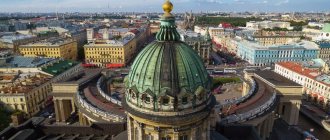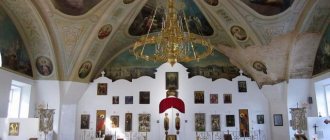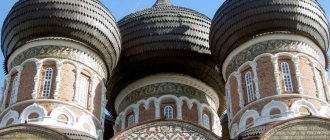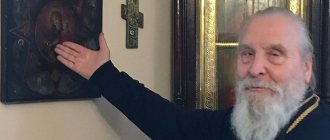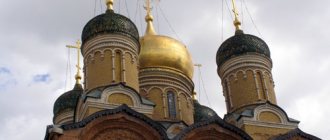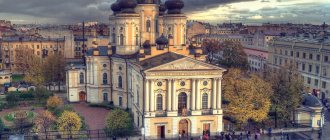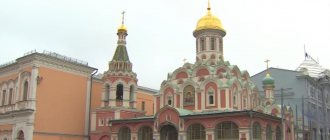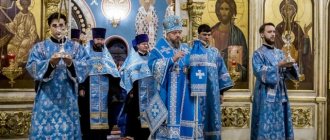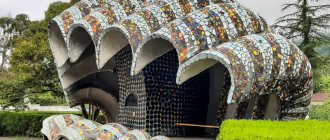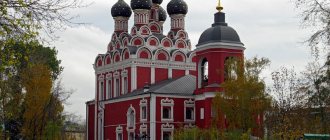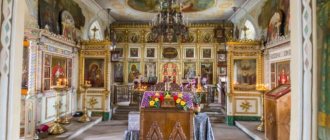Origin of the image
Before the construction of the Cathedral, there was a church here near the fountain. The day before the consecration in 1737, the image of the Mother of God, found in Kazan in 1579, was transferred into it. The icon is a copy (copy), measuring 57.72 x 53.28 centimeters, made from the original image (26.64 x 22.2 cm).
Her story is very mysterious and not without Divine origin. It is good that a manuscript dated 1594 by Kazan Metropolitan Ermolai, which tells about the miraculous appearance of the icon, has survived to this day. According to legend, Russian soldiers during the capture of Kazan in 1552 were helped by the image of the Mother of God.
More than 2 decades after Kazan became part of the Russian state, a terrible fire occurred in the city. Many houses burned down. The same fate befell the monastery of the archer Onuchin. The Mother of God appeared to his eight-year-old daughter Matryona during a dream and showed her the place under the ashes where Her icon was located. Soon the shrine was taken out, and it immediately began to shine radiantly.
There are speculations that it was buried by the Tatars, as well as by some of the Russian captives, or by Muslims who converted to the Orthodox faith. Here, near the hiding place, the Bogoroditsky Monastery was erected. Further, the day when the icon was found became the Feast of the Kazan Image. He showed miracles to the world.
Identical icons were painted from it, and they were distributed throughout Russia. The first was sent to the capital - to Moscow, then to Tsar Ivan the Terrible. In 1708, Peter the Great ordered Praskovya Fedorovna, the widow of his elder brother, Ivan Alekseevich, the Fifth, Tsar from the Romanov dynasty, to deliver the list to the city under construction on the Neva. She fulfilled the will of the sovereign.
At first, the copy of the icon of the Kazan Mother of God was kept in a chapel on Posadskaya Street on the Petrograd Side, near the sovereign’s house. By order of the Empress of All-Russia Anna Ioannovna, the daughter of John V, the Church of the Nativity of the Virgin Mary was built on Nevsky Prospect by 1737. To show the enormous holiness and veneration of the image, they made a chasuble, sparing neither red gold nor precious stones.
Emperor Paul the First, who ascended the throne, the son of Catherine the Great, wanted to erect a great Temple for this miraculous icon in the capital city of Peter, in which he would like to see “a little from St. Peter and a little from Santa Maria Maggiore in Rome,” so that thanks to the greatness The cathedral will put St. Petersburg on a par with the main European Christian capitals. The copy of the image, which rested in the Church of the Nativity of the Virgin Mary, was transferred to the Kazan Cathedral, built in 1811.
Architecture and architect Voronikhin
It cannot be said that Voronikhin created a copy of St. Peter's Cathedral; only the semicircular colonnade reminds of this building. The temple itself is unique. In plan, its configuration resembles a Latin cross.
Colonnades located on the sides, like giant arms, cover the area in front of the temple. The building itself is topped with a huge dome.
On the side of Nevsky Prospekt there are bronze doors, on either side of them in niches there are bronze sculptures of 4 saints :
- Andrew the First-Called
- John the Baptist
- Vladimir Equal to the Apostles
- Alexander Nevsky
In his work, the architect used mainly domestic materials . The columns and bas-reliefs were made from Pudost limestone, the deposit of which is located in the Gatchina region. In the depths of the earth, this stone is quite soft, it was easy to saw it into fragments of the desired shape and size. The limestone hardened in air. To prevent the porous surface from collapsing under the influence of dampness, all outer parts are coated with a special putty that has the same color as the Pudost stone.
96 columns not only decorate the architectural monument, but also disguise the asymmetrical shape of the building. From Nevsky Prospekt, it is not noticeable that the dome is not located above the center of the temple, but is shifted in the eastern direction.
The portals are decorated with magnificent bas-reliefs depicting biblical scenes. 14 giant stone paintings decorate the attics. The length of each of them is about 15 m, in any plot there are more than 40 characters.
Temple relics
Field Marshal General, Commander-in-Chief of the Russian Army during the Patriotic War of 1812, Mikhail Illarionovich Kutuzov, who liberated his native country and all of Europe from Napoleon, died in 1813 in Bunzlau (now the city is known as the Polish Boleslawiec). The Kazan Cathedral was chosen as the burial place. The famous commander found his last refuge next to the image of the Mother of God.
For about 2 months, the funeral cortege with the body of Kutuzov moved from Bunzlau to St. Petersburg, for 2 days the people of St. Petersburg said goodbye to their hero, the great Russian commander. The design of the grave was carried out by the architect of the Kazan Cathedral, Andrei Nikiforovich Voronikhin.
The fence is a low lattice made of dark bronze, with gilded wreaths; the supporting posts are made in the form of cannon barrels with combat helmets on the corner posts. On the marble plaque it says: “Prince Mikhail Illarionovich Golenishchev-Kutuzov-Smolensky. Born in 1745, died in 1813 in the city of Bunzlau.”
At the grave of Field Marshal Mikhail Illarionovich Kutuzov, victorious trophies are placed: banners, standards, eagles, keys to the conquered cities and fortresses of Europe, as well as the baton of the Marshal of France. Since then, the Cathedral has been revered as the Temple of Russian military glory.
In 1837, on the 25th anniversary of the victory over Napoleon, monuments to the greatest Russian commanders Mikhail Illarionovich Kutuzov and Mikhail Bogdanovich Barclay de Tolly were solemnly unveiled on the square in front of the Kazan Cathedral. Their author was the outstanding Russian architect Vasily Petrovich Stasov.
Miraculous appearances of the image
Many chronicles confirm the intercession of the Mother of God for the country and its people. In times of unrest and special hardships, people carried the Kazan Icon of the Mother of God. With her, the people's militia under the leadership of Prince Dmitry Pozharsky liberated Moscow from the Poles in 1612. With prayer requests to the Mother of God, the domestic heroes managed to break the resistance of the gentry.
Since 1613, after the election of the first tsar from the Romanov family, Mikhail Fedorovich, to the Russian throne, the icon of Our Lady of Kazan became a family heirloom of the royal house. In 1648, Tsar Alexei Mikhailovich Romanov gave birth to his first child on the Day of the Kazan Icon of the Mother of God. This heavenly coincidence influenced the fact that the sovereign ordered this holiday to be honored as an all-Russian holiday; before the revolution it was an official holiday.
The icon helped defeat Peter the Great in the battle of Poltava. On the feast of the image, at a solemn service in the Trinity-Petrovsky Cathedral, the people were announced about the victory of Russia in the Northern War. Then Peter the Great was given the title: “Emperor of All-Russia” and the titles: “Father of the Fatherland” and “Great”. Thus, Europe was forced to recognize Russia as a powerful power within Europe.
In the summer of 1812, before leaving for the front, the commander-in-chief of the Russian army, Mikhail Illarionovich Kutuzov, visited the Kazan Cathedral, where he fell before the icon of the Mother of God. Also, as legends say, before taking command of the Russian army in 1812, Kutuzov toured all the troops with the icon of Our Lady of Kazan. The intercessor helped the Russian people win, moreover, liberate the peoples of other countries from Napoleon.
There is such a legend. When Russian troops began to break the blockade of Leningrad, someone gave an unspoken order - to deliver the icon of the Kazan Mother of God to the front and carry the Shrine to all military units. This is probably what happened. This fact was kept silent due to the atheistic views of Soviet leaders.
According to other sources, the icon of the Kazan Mother of God was delivered to Leningrad, surrounded by the Nazis, where it was carried along the outskirts of the city. Later she was transported to Moscow, and then a prayer service was served before her in Stalingrad. Believers are still confident that it was the miraculous image of the Kazan Mother of God that helped Soviet soldiers break through the blockade ring in 1943, completely liberate Leningrad from the enemy blockade in 1944, and win the great Victory in 1945.
Helpful information
Kazan Cathedral: opening hours from 7:00 to 20:00
Every day services are held in the cathedral church. Admission is free.
Opening hours and service schedule:
- On weekdays, holidays and Sundays, the Liturgy is served at seven and ten o'clock in the morning; evening service - at six o'clock in the afternoon.
- The cathedral is open every day from 7 am, on Sundays and holidays - from half past seven in the morning. After the evening service ends, the cathedral closes.
- Church Sacraments and short services are performed in the church: memorial services and prayer singing, and a clergyman is constantly present.
Soviet past
In the 20s of the last century, the temple lost its church values. But, Thank God, his main Shrine has been preserved. Although she had to change monasteries more than once. Her salvation was due to the love and efforts of believers.
At first, the image was kept in the Spaso-Uspensky Church. After its closure in 1937, the icon was transferred to the Church at the Smolensk cemetery. In 1940, it was also closed, and then the shrine moved to the Prince Vladimir Cathedral. Here she stayed until her return to the Kazan Cathedral in the summer of the first year of our millennium.
Divine services
Kazan Cathedral is a functioning Orthodox church.
Services are held daily at 7, 10 and 18 o'clock
Church sacraments are held here . Even if you are an atheist or a follower of another religion, be respectful of the parishioners. At all times, people wore formal clothes to the temple, and now it is not recommended to enter any church in tracksuits or in too revealing outfits. Women are required to cover their heads and men are required to remove their hats.
Turn off your cell phone sound. If you need to talk urgently, go outside. You need to communicate with each other in a quiet voice. During services, access of tourists to areas where parishioners pray may be limited.
Celebration of the shrine
Since 2005, on November 4, the celebration of the Day of Military Glory and the Day of National Unity of Russia has been added to the holiday of the Kazan Icon of the Mother of God. The Kazan image helped Russians resist division and Troubles and become a unified power.
With prayers to the Mother of God, the people managed to save Rus' from the raids of the Horde, Crimean and Kazan khans, free it from all its foreign invaders, repel the attacks of enemies on their native country, and give it the long-awaited peace. And today we must learn from history and understand that our strength is in faith and unity.
Afterword
The sad fact is that the original - the prototype of the list of the Kazan Mother of God disappeared at the beginning of the 19th century. According to one version, it is believed that the icon was stolen from the Bogoroditsky Monastery for the sake of selling the jewels of the robe. The face itself was allegedly chopped into pieces and burned. They also claim that at the time of the theft there was a copy, and the original is still in the hiding places of the monastery.
They also write that during the Civil War, the prototype of the icon of the Kazan Mother of God was taken out of Russia. In 1920, the icon was sold at auction to a collector from London. Later it belonged to many owners. Finally, there are good fabrications, they say, the prototype returned to Russia in 2004.
But it is not known for certain whether this is true or not, as well as the exact location of the original holy image. But we have a prayer and a list of icons in front of which we can pray, and everything in life will be great!
Description of the face of the Most Holy
The icon belongs to the “Hodegetria”, or “Guide” type. Which means that the Most Pure One leads and directs the believer to Her Son, Jesus Christ. Taking into account the circumstances of the acquisition of the shrine, its special help in life’s difficulties, it is clear that the Most Pure One shows: Christ is the only goal, the support of the believer, no matter how difficult the misadventures of his life may be.
Iconography
Patriarch Hermogenes, who found the shrine, points out its unusualness, “as if such a translation of the image has not been seen anywhere.” Indeed, Kazanskaya differs from the usual Hodegetria in that the Divine Infant is written standing, and not sitting on the Mother’s lap. Modern experts believe that such icons appear in Russia under the influence of Italian Renaissance art, however, they adapt to the local tradition.
In addition, Kazan is an “abbreviated” version of the Hodegetria, that is, it represents a chest-to-chest image of the Most Pure One and Christ. Such icons, very small, have been spreading throughout Russia since the 16th century. They were especially popular among service people who wanted to have a small “prayer image” with which it would be convenient to go on long hikes.
Prayer to the Kazan Icon of the Mother of God
Oh, Most Holy Lady, Lady Theotokos! With fear, faith and love, falling down before Your honest and miraculous icon, we pray to You: do not turn Your face away from those who come running to You. Deliver all those who pray to You with faith from the falls of sin, from the slander of evil people, from all temptations, sorrows, illnesses, troubles and sudden death. Grant us the spirit of contrition, humility of heart, purity of thoughts, correction of sinful life and remission of sins, so that all who gratefully sing of Thy greatness and mercy, manifested over us here on earth, may be worthy of the Kingdom of Heaven, and there with all the saints we will glorify the most honorable and magnificent name of the Father and the Son and the Holy Spirit forever and ever. Amen.
Colonnade
According to religious canons, the entrance to the cathedral should be from the west, the altar should be in the east. Compliance with this rule made the temple turned sideways towards Nevsky Prospekt. To create the main entrance from the north, Voronikhin designed a monumental semicircular colonnade of 96 columns 13 meters high. Each Corinthian column made of lime tuff, ending with an intricate capital, individually is also an architectural masterpiece, embodying the filigree work of the builders.
What we couldn’t implement
Voronikhin’s ideas were not fully realized - the southern colonnade was not installed, but the northern one became an undoubted decoration of Nevsky Prospekt. The sculptures of the archangels Michael and Gabriel on the pedestals on both sides of the colonnade and the planned fence at the western entrance in front of the square are missing. Despite this, the colonnaded structure of the Kazan Church is not inferior in grandeur and beauty to Peter’s Cathedral in Rome.
